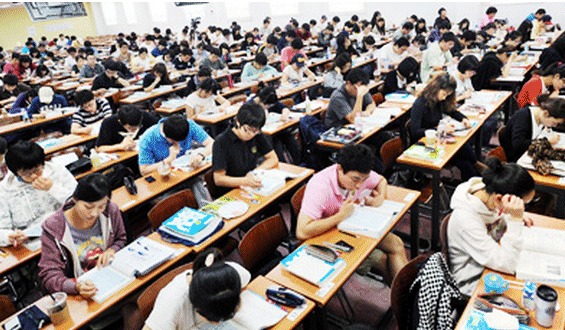
Try looking at the world with a pair of Korean glasses on: Part 4
In my previous three blogs I have discussed how there are culture differences you and I need to navigate here in Korea or we could find ourselves in tricky situations. Therefore, we need to take off our western glasses and replace them with Korean or Asian glasses.
EDUCATION IS “KING” IN KOREA!
One of these is in the area of education which is founded on Confucianism ideals. I mentioned that you don’t need to go far before seeing the influence of Korea’s own brand of Confucianism, called Neo-Confucianism, which was firmly established in their longest Kingdom or dynasty called the Joseon Dynasty, a kingdom that lasted for five centuries until Korea became a protectorate of Japan in 1895 when Japan forced Emperor Gojong of Korea to abdicate his throne, and assassinated his wife, Empress Min of Joseon. The event is recalled both in books and at the historical site itself, (Changdeok Palace in Seoul). Queen Min’s brutal murder — she was stabbed repeatedly, cut into pieces, desecrated, and thrown into a fish pond — received little attention outside of Korea; the events were not widely known for decades.
The 5o2 year old dynasty came to an end.
Japan annexed Korea in 1910 and Korea became a Japanese colony until, of course, when she surrendered in 1945, at the end of the second world war.
Officially, however, the Joseon dynasty lasted from July 1392 to October 1894 when officially a new Korean dynasty was declared as a way of asserting Koreas independence from China and Japan against their various ambitions on Korean land. The Joseon court in 1894, pressured by encroachment from larger powers, felt the need to reinforce national integrity and declared “The Great Han Empire” (대한제국 大韓帝國). King Gojong assumed the title of Emperor (황제 皇帝) in order to assert Korea’s independence by putting himself on the same level as the Chinese Emperors. In addition, other foreign powers were sought for military technology, especially Russia, to fend off the Japanese. Technically, 1894 marks the end of the Joseon period, as the official name of the state was changed; however, the Yi Dynasty would still reign, albeit perturbed by Japanese interventions such as in 1895, when the Japanese murdered Empress Min of Korea, apparently orchestrated by Miura Goro because the Korean Empress was effective in keeping Japan at bay. In 1910 Japanese annexation of the Korean peninsula effectively ends the Yi Dynasty rule.
However, Korean culture is still seeped in Confucianism or under the Joseon dynasty, a form of Confucianism, called a Neo-Confucianism; wherever you go, whether you set foot in a Kindergarten or a Church, there are strong ties of this yesteryear hierarchical society; the Joseon Dynasty was founded following the aftermath of the overthrow of the Goryeo dynasty in what is today the city of Gaesong. Under the Joseon dynasty, the city was relocated to Hanyang, which is the old name of Seoul. Of course, its most famous King is King Sejong,(세종대왕 ), who, along with his scholars, invented the Korean alphabet which replaced around five thousand Chinese characters with just which meant every sound was designated by a Korean letter. It is a engenius invention but it lacks some important sounds – for example, they cannot pronounce the letter “F” or “V” or “X” sound because they have no such character sounds in their alphabet.Hangeul, the Korean alphabet, was created in 1443 by Sejong, the fourth king of the Yi Dynasty or Joseon dynsty. The Korean alphabet consists of 40 letters, including compounds: 10 pure vowels, 11 compound vowels, 14 basic consonants, and 5 double consonants. The basic Korean alphabet, though, consists of only 10 vowels and 14 consonants.
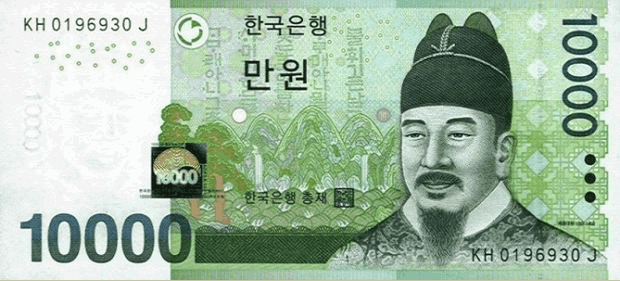 (1397-1450)
(1397-1450)
The capital was relocated to modern-day Seoul (서울) And also, the country was renamed Corea until the Japanese replaced the letter “C” with “K” so as to proceed their letter of “J” in the Olympic line-up of countries when each country came out by alphabetical order, at the opening ceremony in their national teams. Joseon was the last dynasty of Korean history and the longest-ruling Confucian dynasty. During its reign, Joseon encouraged the entrenchment of Chinese Confucian ideals and doctrines in Korean society. Neo-Confucianism was installed as the new dynasty’s state ideology. This is why if you care to look at the front side of your 1,000 won or 5,000 won Korea bank denominations , you will find the two of the most noted Korean Confucian scholars. On the 5,000 note you can find Mr. Yi I (이이),
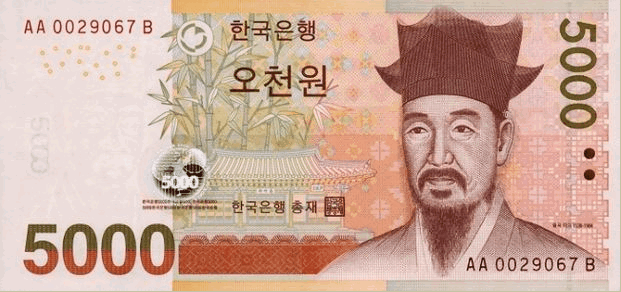 (1501-1570)
(1501-1570)
who is the son of the face of the lady you can find on the 50,000 won note of his mommy. According to history, by 3, Mr. Yi I was reading, by 7 he was done with his Confucian classics lessons, by 13 he passed the Civil Service literary exam! It was a one-day test of Confucius literature and the only way of bettering yourself and breaking free from the class which you had found yourself born into, unless you were born with “a silver spoon in your mouth,” meaning unless you were born with blue blood running through your veins, i.e. aristocracy.
And his Mommy in the photo album is this lady who was a famous poet as well as Mother!
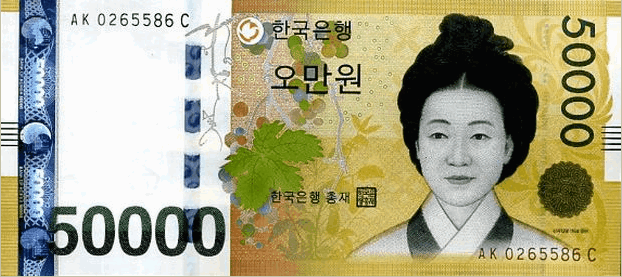 (1504-1551).
(1504-1551).
Shin Saimdang 신사임당)
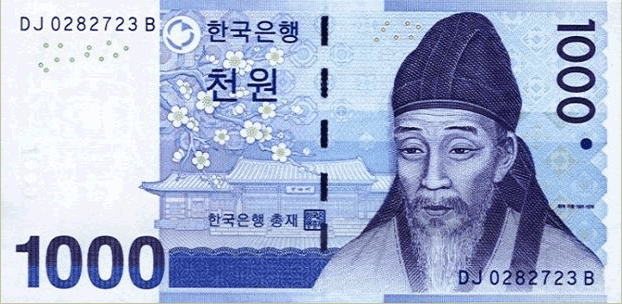 (1501-1570)
(1501-1570)
On the 1,000 note above you can find another Neo-Confucius scholar by the name of Yi Hwang (이황), who is not related to the above two, but, as you can see by the dates, were contemporaries, and may have been something of philosophical rivals! (Maybe they competed on social media to see who acquired the most number of followings – just kidding!) While Mr. Confucius himself, you cannot find (or as his Chinese rendering name is:Kong Qui, which, if you render this by its English latinized or Romanized version, becomes “Confucius” which is derived from “Kong Fuzi”)
If you want to understand why education is so important in Korea, it has it roots in Confucianism where he taught five hundred years before Christ that the only way to progress in life, was by study and self-reflection rather than by war-lord fighting. Of course, if you are a sincere Christian you would say that such a teaching lacks the real power of self-control which Christians are empowered with by the indwelling of God’s Holy Spirit. And such a Spirit needs to even break in and conquer the spirit of Confucianism within Korean Churches. By the way, according to Confucius, the main foundation of his teaching was first respect for parents; if the husband of the wife died,that authority was given to the Son, which the Mother had to acknowledge; in other words, in Korean society, all legal rights went to the son automatically and by-passed the Mother – this is also different from Western society when all rights are bestowed after the death of both Mother and Father, normally. Even in contemporary Korea , if you ask, “Who will own this house after the Father dies?”, normally ownership goes to the Firstborn.
Education, of course, is exceedingly competitive here in Korea, and open to the cut-throat forces of free-enterprise, both public and private, as well as Universities and other institutions, which we wouldn’t find back home in the U.S. States’ or my home of England. Such as the rampant sight of study academies on almost every street corner in the main byways and highways of each town-center. Probably around half of students attending public schools nowadays, after they have finished their public school, they clock-on in their private academies of learning around 3.00 a’clock in the afternoon, and this means so many students are studying most of their day. From High School, their schedule in their public school can be until 10 a’clock at night. Did you know that Korea is the only country in the world which a few years ago their politicians were debating an amendment to their laws which would have made it illegal for children to study in hagwons (academies of learning) after 10 p.m.? Korea education is also state-standardized test dominated, which means every student,unless given special exception has to be tested on one day of their life, their entire academic prowess is tested consisting of test for Maths,English and Social science, which also has its roots in the old Neo-Confucian Civil Servant Exam or Civil Service literary exam, except in that case the subject was only Confucius writings and literature, which all those who had aspirations in serving the king and his government had to take; for those unfortunates who were not born into aristocracy this test was the only hope of breaking free from their own rank or class within Neo-Confucian society where they found themselves in Korean society. If was in many respects similar to the English feudalism system but without the Confucian ideals, of course, in so much as it was a society where most of the population were the working class within their agricultural lifestyle (around 80% of the populous); however, the only way to break free from each respective class for the under-privileged was to study and take that one exam civil service literary exam; therefore, this is the roots of the much notorious national SAT test of contemporary Korea, the standardized test for all Koreans, from genius to not-so-genius, which all third year high school Korean students have to take every year in the second week of November, and is the main culprit for so much suicide as a result of having to devote all one’s hope of their future pinned on one exam on one day, with the resultant intense pressure and stress!
But in Confucian times, the scholar-gentry (yangban) were officially recognized as the leading class and accorded privileges. Beneath them were the craftspeople, held with some esteem because of their skills. Below the craftspeople in the official order were the common people (about 80 percent of the population) – those who worked the land. Few of them owned their own land. Most worked for landowners and were not free to leave their landlord without permission from the king. But they were described as “the foundation of the nation.”
Recognized as being below farm laborers were the merchants, fitting with the Confucianism view of commerce as greed and dishonesty. Today we call this lass of people, all those people who call themselves businessmen or woman. Also below the farm laborers were those called the low-born (ch’onmin): butchers, gravediggers, those who worked with leather, basket makers, those who peeled bark, sorcerers, those in public entertainment, and that fifth or so of the population who were slaves.
Thus, this may shed light on why Koreans think so much about study and why they believe it is the key to their future as well as why they badger young students to just study!
